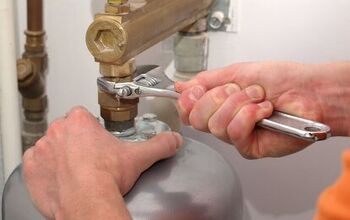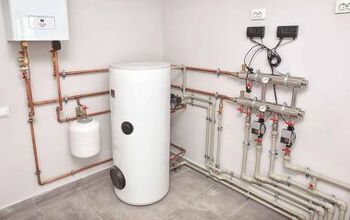Cost to Install a Water Heater Expansion Tank

A water heater expansion tank is a safety feature that protects your water heater and pipes from extreme pressure. It works by accepting overflow water from the water tank anytime the pressure gets too high. An expansion tank is only mandatory in homes with closed-system water heaters, featuring pressure limiting valves or backflow preventers. Luckily, the cost to install a water heater expansion tank is not overly expensive.
The cost to install a water heater expansion tank is between $200 to $500, but can be as low as $40 if you do it yourself. The water heater expansion tank itself costs between $40 and $70, depending on size and material. You also need to account for mounting materials, additional piping, and other supplies, which cost between $140 and $350.
You can save a lot by completing this as a DIY project if you are confident in your plumbing skills. If you hire a professional to do the installation for you, the total will be closer to the $500 estimation.
Do You Need Water Heater Installation or Replacement?
Get free, zero-commitment quotes from pro contractors near you.

Adding Up The Cost To Install A Water Heater Expansion Tank
When determining the total cost to install a water heater expansion tank, it’s more than the cost of the tank. You also need to consider other supplies needed for the job. Plus, if you don’t have the necessary plumbing skills, you need to hire a professional, meaning extra labor costs.
Here’s an overview of the different factors affecting the cost to install a water heater expansion tank.
The Cost Of The Water Heater Expansion Tank
| Expansion Tank Size | Average Price |
| 2-gallon | $20 – $40 |
| 4-gallon | $50 – $70 |
The most common sizes of water heater expansion tanks are 2, 2.1, 4.5, or 4.8 gallons. A 3-gallon tank is less common, but you can definitely find one if you search a little. Because expansion tanks are just meant to hold overflow from your water tank, the exact size is not important.
As long as your expansion tank is large enough to hold the excess water, you will be fine. If you do not know what size you need, it is very easy to determine. You can scroll down for more information on how to figure out what size water heater expansion tank is right for you.
More durable products, like steel tanks, and products from companies offering longer warranties will be a bit more costly. Either way, you can see that all of these expansion tanks are very affordable. Therefore, you won’t be surprised to learn that the majority of the cost of this project is actually for labor.
Labor Costs To Install A Water Heater Expansion Tank
| Contractor | Labor Rates |
| Licensed Plumber | $75 – $150 |
| Handyman | $60 – $100 |
As you can see, the hourly rate for the installation of your expansion tank will likely be around $100. The labor cost of hiring a professional to install your expansion tank will be the majority of this project cost. At the very least, it will definitely prove to be more expensive than the tank itself.
The Estimated Time to Complete the Installation of a Water Heater Expansion Tank
Labor costs are why experienced DIY enthusiasts may choose to take on the project themselves. You can save a lot of money this way, decreasing the project cost by more than half. However, it is recommended that you have some plumbing experience before going this route.
If you do not have plumbing experience or the tools for the job, hire a professional. Below is an estimation of the time it takes to complete this project. Luckily, you can see that it is a very simple installation for a professional, so the labor cost would be minimized.
| Installer | Project Completion Time |
| Professional Plumber or Handyman | 1 – 2 hours |
| DIY Enthusiast (You!) | 2 – 4 hours |
Additional Materials: Cost To Install A Water Heater Expansion Tank
Hopefully, the above charts will help you to better understand the cost of your expansion tank installation project. Before you move forward, however, there are a few other expenses to be aware of. Aside from the tank and labor, there are the costs of additional material and tools if you do not have them.
This is a significant component to factor in before starting the project. If you’re a regular DIY enthusiast, then you would likely have the necessary tools already.
If you have not done any plumbing work before, there are a few tools you will need to buy to complete this project. These costs are cheap, but they will increase your project’s overall cost by quite a bit, percentage-wise. However, you still need to buy the necessary supplies.
| Additional Materials | Cost |
| Tank Mounting Brackets | $50 – $200, depending on the material |
| Hanging Strap (as an alternative for mounting) | Around $10 |
| Necessary Piping | Around $15 |
| Tools Needed | Cost |
| Pipe Cutter | Around $20 |
| Pipe Wrench | Around $15 |
| Soldering Kit | $30 – $50 |
A contractor would charge you for the additional materials, but obviously not for the tools. Therefore, if you haven’t done any plumbing work before, you might be better off hiring a professional. Not only will you save money on tools, but you can also be confident in the integrity of the work.
With all of this information, you should be able to approximate your project’s total cost. Hopefully, you can use this information to decide if paying a professional makes sense for you. You can continue reading to see if the expansion tank is worth the cost for you, too.
What Is The Purpose Of A Water Heater Expansion Tank?
As you might remember from your high school chemistry class, water expands as it heats up. In a closed container, like a water heater, this creates added pressure that can strain your tank and pipes. In order to protect your tank and ensure a longer shelf life, expansion tanks are connected to accept overflow.
Expansion tanks are only required by building codes in certain circumstances. For example, open water heater systems allow the hot water to move into the surrounding pipes and disperse the pressure.
This makes expansion tanks unnecessary, though some people have them to be safe. Additionally, tankless water heaters, which work by pumping the water through burners on demand, will never have this problem.
Because the expansion tank is only meant to store overflow, they do not need to be very large. You can see in the chart below that they are relatively inexpensive. If you are unsure if you need an expansion tank and if so, what size, you can ask your plumber for a recommendation.
What Size Water Heater Expansion Tank Do I Need?
A typical family house will not need more than a 2-gallon expansion tank. However, it is a good idea to do your research and make sure to get the correct size for your water heater. Below are the instructions you can follow, as well as a chart, to help you find your proper tank size.
Determining Your Water Heater Expansion Tank Needs
The size expansion tank you need depends on two factors. These are the size of your water heater and the water pressure within your plumbing system. To determine this for yourself, first, check the capacity of your water heater to get the right size. It should say right on the tank, or you can check the manufacturer’s information.
Second, to figure out the water pressure of your system, you can use a pressure gauge on any faucet. Simply run the water a few times throughout the day to make sure to find the average. Alternatively, if you do not have a gauge, you can call your water company to ask.
Recommended Water Heater Expansion Tank Sizes
Once you know this information, you can use this chart to figure out the proper size water heater expansion tank. Note that the expansion tank sizes recommended are approximate. As noted above, a 2.1-gallon tank (instead of 2 gallons) or 4.5-gallon tank (instead of 4 gallons) is okay.
| Water Heater Size | Water Pressure | Expansion Tank Size |
| 40 – 60 gallons | 40 – 50 psi | 2-gallon |
| 40 – 60 gallons | 60 – 80 psi | 3-gallon |
| 60 – 80 gallons | 40 – 50 psi | 3-gallon |
| 60 – 80 gallons | 60 – 80 psi | 4-gallon |
A typical residential, family home will have a 40-gallon, 50-gallon, or 60-gallon water heater tank. For a tank this size with a standard pressure of 40 psi or 50 psi, a 2-gallon expansion tank is plenty. For up to an 80-gallon water tank with a high supply pressure of 80 psi, a 4-gallon expansion tank is recommended.
Because they are inexpensive, you should feel free to go a little bigger to be safe. If you are unsure what size to get, there is no downside to a slightly too large, 4-gallon tank. Additionally, you can always contact your local plumber for a consultation or advice.
Do You Need Water Heater Installation or Replacement?
Get free, zero-commitment quotes from pro contractors near you.

Related Questions
Can you install a water heater expansion tank upside down?
Yes, it is perfectly fine to install a water heater expansion tank upside down. In fact, most are installed upside down and directly on top of the water heater. They can also be installed sideways, as sometimes this is easier. In this case, you would use a tee connection to attach the expansion tank to the cold water line.No matter what direction you install it in, the water heater expansion tank will function properly. You should not expect any adverse effects due to the installation position of the expansion tank.What is more important is that you properly support the tank. The first time it fills, the extra weight could cause the mounting pipe to break. Be sure to install the expansion tank with proper support, no matter what position it is in.
How long will my water heater expansion tank last?
Expansion tanks typically last between five and ten years. There is a rubber diaphragm in the expansion tank that separates the water and air. This piece normally wears out first and requires a replacement.In order to ensure the health of the expansion tank, there are two things to keep in mind. First, make sure it is mounted securely and supported so the connecting pipe is not strained.Second, you need to make sure that your water heater and your expansion tank have consistent air pressure. This is called setting a “pre-charge” in the air part of the expansion tank. This is very important, as any difference will lead the expansion tank to function incorrectly.Too low pressure will mean more water than necessary flows to the expansion tank, so it will get old more quickly. Too high pressure will mean that the water does not flow when it needs to, which could lead to a failure in the tank itself.
Do you have to replace the expansion tank when you replace the water heater?
There is no need to replace the expansion tank and water heater at the same time.

Benjamin is a freelance writer and graphic designer. He is passionate about DIY projects and finding creative ways to upcycle things headed for the landfill. Based in Oakland, CA, Benjamin enjoys playing guitar and gardening.
More by Benjamin Panico













![How Much Weight Can a 4×4 Support Horizontally? [It Depends!]](https://cdn-fastly.upgradedhome.com/media/2023/07/31/9070333/how-much-weight-can-a-44-support-horizontally-it-depends.jpg?size=350x220)













